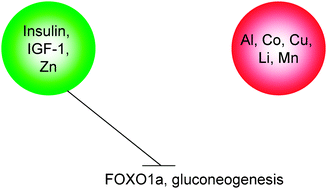Metal-binding compounds have recently been reported to have anti-hyperglycaemic properties in vivo. In the current study, we have investigated the ability of these compounds and related structures to induce insulin-like signal transduction to downstream effectors such as the transcription factor FOXO1a and the key gluconeogenic regulatory enzymes phosphoenolpyruvate carboxykinase (PEPCK) and glucose 6-phosphatase (G6Pase). Our results indicate that β-thujaplicin, diethyldithiocarbamate (DEDTC) and its clinically-used dimer disulfiram, induce insulin-like dose-dependent effects on signalling to FOXO1a in a manner that is strictly dependent on the presence of zinc ions, as other ions including aluminium, cobalt, copper, lithium and manganese cannot substitute. The most potent compound tested on gluconeogenesis is disulfiram, which in the presence of 10 μM zinc, inhibited both PEPCK and G6Pase with an IC50 of 4 μM. Our results demonstrate that metal-binding compounds with diverse structures can induce zinc-dependent insulin-like effects on signal transduction and gene expression.

You have access to this article
 Please wait while we load your content...
Something went wrong. Try again?
Please wait while we load your content...
Something went wrong. Try again?


 Please wait while we load your content...
Please wait while we load your content...